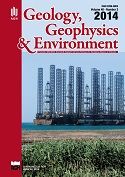Raster images generalization in the context of research on the structure of landscape and geodiversity
DOI:
https://doi.org/10.7494/geol.2014.40.3.271Keywords:
generalization, raster, landscape, geodiversity, Boundary Clean, Majority FilterAbstract
Generalization is one of the most important stages of work on cartographic data. It has a particular importance in the study of landscape structure, especially geodiversity. In raster images, it is based on modifying the structure of the image while maintaining its general characteristics. In ArcGIS software, the most important tools for generalization of raster images include: Boundary Clean and Majority Filter. Fragstat software was used for the analysis of structural modifications of the output images and assessment of the effects of generalization. Depending on the options used, both tools (Boundary Clean and Majority Filter) cause different types of modifications in rasters. Elimination of the so-called noise using one of the variants of Majority Filter is the most suitable if we wish to introduce only subtle modifications to the final image. If, however, we expect a greater level of interference in the structure of the source images, using Boundary Clean becomes necessary.
Downloads
References
Bartuś T., 2014. Topoklimaty Ojcowskiego Parku Narodowego. [in:] Kalinowska-Szymczak A. (ed.), Kalejdoskop GIS, tom 3, Esri Polska sp. z o.o., 102–103.
Beat P. & Weibel R., 1999. Using Vector and Raster-Based Techniques in Categorical Map Generalization. Third ICA Workshop on Progress in Automated Map Generalization, Ottawa, 12–14 August 1999, 1–14.
Chrobak T., 2005. Komputerowa redakcja kartograficzna wspomagana automatyczną generalizacją. Geoinformatica Polonica, 7, 7–14.
Daley N., Goodenough D.G., Bhogal A.S., Bradley Q., Grant J. & Zin Y., 1997. Comparing Raster and Object Generalization, Proc. IGARSS’97, Singapore, 677–679.
ESRI, 2012. ArcGIS Desktop: Release 10.1. Redlands, CA: Environmental Systems Research Institute.
Harrie L. & Sarjakoski T., 2002. Simultaneous Graphic Generalization of Vector Data Sets. GeoInformatica, 6, 3, 233–261.
Hengl T., 2006. Finding the right pixel size. Computers and Geosciences, 32, 1283–1298.
Jaeger J.A.G., 2000. Landscape division, splitting index, and effective mesh size: new measures of landscape fragmentation. Landscape Ecology, 15, 115–130. Kicińska B., Olszewski K. & Żmudzka E., 2001. Uwagi o wykorzystaniu klasyfikacji J. Paszyńskiego do kartowania topoklimatycznego (z doświadczeń Zakładu Klimatologii Uniwersytetu Warszawskiego). [in:] Kuchcik M. (ed.), Współczesne badania topoklimatyczne. Dokumentacja Geograficzna, 23, IG i PZ PAN, Warszawa, 143–151.
Kot R., 2005. Ocena georóżnorodnosci klimatu na przykładzie fordonskiego odcinka doliny dolnej Wisły i jej otoczenia w skali 1:25.000. [in:] Szponar A. & Horska- -Schwarz S. (eds), Struktura przestrzenno-funkcjonalna krajobrazu. Problemy ekologii krajobrazu, XVII, 257–271.
Kot R., 2006. Georóżnorodność – problem jej oceny i zastosowania w ochronie i kształtowaniu środowiska na przykładzie fordońskiego odcinka doliny dolnej Wisły i jej otoczenia. Towarzystwo Naukowe w Toruniu, Uniwersytet Mikołaja Kopernika, Toruń.
Kot R. & Leśniak K., 2006. Ocena georóżnorodności za pomocą miar krajobrazowych – podstawowe trudności metodyczne. Przegląd Geograficzny, 78, 1, 25–45.
McGarigal K., Cushman S.A. & Ene E., 2012. FRAGSTATS v4: Spatial Pattern Analysis Program for Categorical and Continuous Maps. Computer software program produced by the authors at the University of Massachusetts, Amherst, [on-line:] http://www.umass.edu/landeco/research/fragstats/fragstats.html) (access: 10.06.2013).
McGarigal K. & Marks B.J., 1995. FRAGSTATS: spatial pattern analysis program for quantifying landscape structure. USDA Forest Service, Technical Reports, PNW-GTR-351, Portland.
McMaster R., 1992. Generalization in Digital Cartography. Association of American Geographers, Washington
Milne B.T., 1988. Measuring the fractal geometry of landscapes. Applied Mathematics and Computation, 27, 67–79.
Paszyński J., 1980. Metody sporządzania map topoklimatycznych. [in:] Metody opracowań topoklimatycznych. Dokumentacja Geograficzna, 3, 13–28.
Raines G.L., 2002. Description and comparison of geological maps with FRAGSTATS – a spatial statistics program. Computers and Geosciences, 28, 169–177.
Shannon C.E. & Weaver W., 1949. The mathematical theory of communication. Univ. Illinois Press, Urbana.
Simpson E.H., 1949. Measurement of diversity. Nature, 163, 688–688.
Tadeusiewicz R., Korohoda P., 1997. Algorytmy i metody komputerowej analizy i przetwarzania obrazów. Materiały do Szkoły Letniej, Tempus S_JEP-07181-94, Kraków.
Urbański J., 2012. GIS w badaniach przyrodniczych. Wydawnictwo Uniwersytetu Gdańskiego, Gdańsk.
Veregin H. & McMaster R., 1997. Data Quality Implications of Raster Generalization. ACSM ASPRS Annual Convention and Exposition, 5, 267–276.
Weibel R. & Jones Ch.B., 1998. Computational Perspectives on Map Generalization. GeoInformatica, 2, 4, 307–314.
Zwierzchowska I., Stępniewska M. & Łowicki D., 2010. Możliwości wykorzystania programu Fragstats w badaniach środowiska przyrodniczego. Przegląd Geograficzny, 82, 1, 85-102.
Downloads
Published
Issue
Section
License
Authors have full copyright and property rights to their work. Their copyrights to store the work, duplicate it in printing (as well as in the form of a digital CD recording), to make it available in the digital form, on the Internet and putting into circulation multiplied copies of the work worldwide are unlimited.
The content of the journal is freely available according to the Creative Commons License Attribution 4.0 International (CC BY 4.0)










